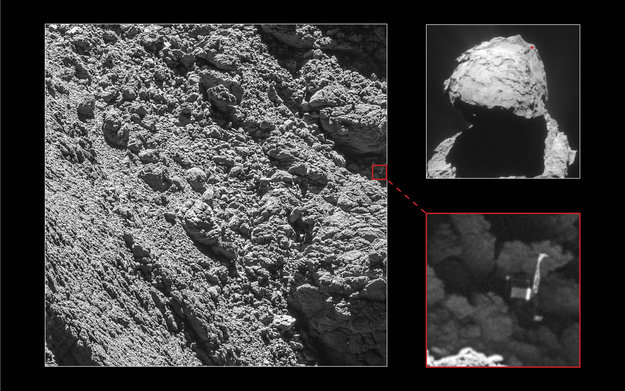Two years ago I posted about the rendezvous of comet chaser Rosetta with Comet 67-P Churyumov-Gerasimenko. It was a wonderful achievement for the European Space Agency. Two months later on November 12, 2014, Rosetta launched a probe, named Philae, to land on the comet. Communication with Philae proved very difficult and it has been essentially “lost.”. According to Cecilia Tubiana of the Space Agency’s OSIRIS camera team, on Monday, “With only a month left of the Rosetta mission, we are so happy to have finally imaged Philae, and to see it in such amazing detail.”
This kind of image, which after all is of a piece of discarded space-junk, falls into the category of the well-known question, “if a tree falls in the forest, and there is no one there to see, does it really happen?” The profundity of the issue comes from the fact that even if we include all of the alien extant species that have developed a photography, there are only a finite number of cameras in the universe, but at any moment, there are an infinite number of scenes to photograph.
Well, you could argue that last point. Arguably there are only a finite number of subjects as well – a very large finite number. But the point remains. Somewhere on an unknown planet right now a chilling gust of methane picks up and scars the scenery. But there is no one to see it. And the question of its significance dependence upon whether you take a classical mechanical deterministic view, where at some level everything depends causally on what preceded it, or a quantum mechanical view where there is ultimately chance and probability at work.
But what of a piece of space-junk that now will go unnoticed in its journey through the solar system for millions of years? I remember when men first landed on the moon, thinking that someday other men, tourists in fact, would return to that site and take its picture. The significance of space-junk lies not in the junk itself but in the hearts and minds of those who built it and those who guided it there. If some day it is encountered and photographed again the significance will be in the transcendence of space and time that takes those who see it and who see the photograph back to those hearts and minds. The whole point of photograph is ultimately one of inter human (?) communication and of extending ourselves beyond ourselves.

